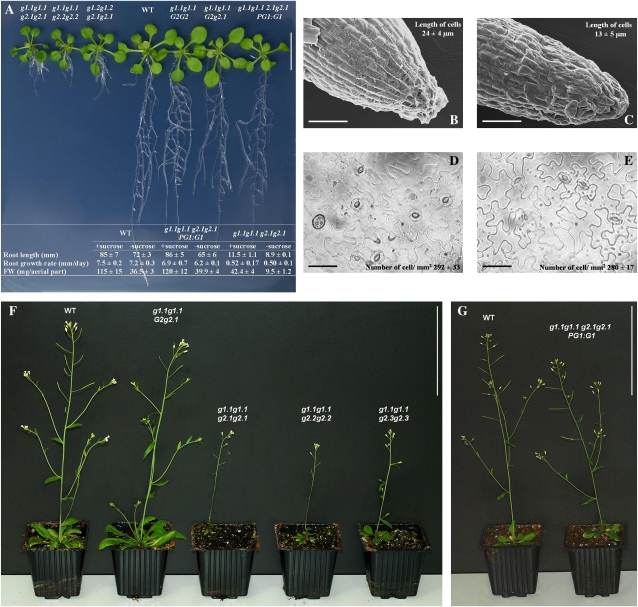Figure 6.
Phenotypic characterization of gapcp mutants and complemented lines. A, Phenotypic changes in the gapcp mutant. Plants were grown for 18 d on one-fifth-strength MS plates. Double mutants (g1.1g1.1 g2.1g2.1, g1.1g1.1 g2.2g2.2, and g1.2g1.2 g2.1g2.1) showed arrested root development. Single mutants (g1.1g1.1 G2G2), heterozygous lines (g1.1g1.1 G2g2.1), and gapcp double mutant complemented with a genomic GAPCp1 construct (g1.1g1.1 g2.1g2.1 PG1:G1) had normal root development as compared with control plants (WT). At bottom are data of the final root length, root growth rate, and aerial part fresh weight (FW) of the wild type, double mutant, and complemented line. Measurements (mean ± sd; n ≥ 30) were made in plants grown with or without 1% (w/v) Suc. B and C, Size of the root epidermal cells is reduced in the gapcp double mutant. Electron microscopy of wild-type (B) and gapcp double mutant (C) roots is shown. Measurements are means ± sd (n = 3). D and E, Bright-field inverted microscopy images showing that the size of the epidermal cells in leaves is not reduced in the gapcp double mutant (E) as compared with the wild type (D). Measurements are means ± sd (n = 3). F, gapcp double mutants (g1.1g1.1 g2.1g2.1, g1.1g1.1 g2.2g2.2, and g1.1g1.1 g2.3g2.3) are dwarf in the adult stage. Heterozygous plants (g1.1g1.1 G2g2.1) are not different from wild-type plants. G, Complementation of gapcp double mutants with a genomic GAPCp1 construct (g1.1g1.1 g2.1g2.1 PG1:G1) rescues the wild-type phenotype. For simplicity, g stands for gapcp and G stands for GAPCp. Bars = 1 cm (A), 50 μm (B–E), and 10 cm (F and G).

